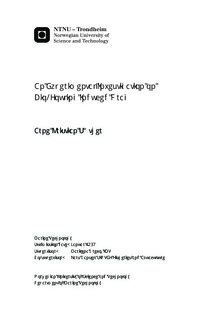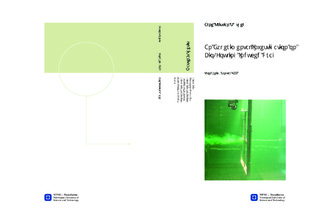| dc.description.abstract | Marine fish farming is an important and growing industry. Fouling organisms that grow on the net cages and other structural components of the fish farms are a substantial problem for the industry. The overall aim of this study is to increase the understanding of how the bio fouling influence the hydrodynamic forces on the nets. More specifically the focus is on hydroid growth, and the use of models of net twine with artificial hydroid fouling.
The models that were used ar made of two 1.5 mm steel rods that are twisted together, with short pieces of 0.32 mm multifilament fishing line fixed between them, similar to a test tube brush. The twisted steel rods were replicating a 3 mm twine, with the fishing lines acting as evenly distributed hydroid growth. Previously drag tests had been done with one and two of these models, with two parallel twines with variyng distance, and also a cross configuration. In the present study the goal was to investigate possible interaction effects between twines, by using various configurations with a higher number of twines; and also make small net sections and estimate the drag increase due to bio fouling. 16 twine models were made, and tests were done with a single twine; and 2, 4, 6 and 8 parallel twines; and also crossing twines, with the same numbers of twines in each direction. In total 18 different configurations were tested, with twine spacings of 12 mm and 24 mm.
The experiments were done in a towing tank, with the twine models fixed in a frame, orthogonally to the direction of travel.The drag force was measured on the frame, and the contribution from the frame itself was subtracted from the total force to find the drag on the twine models. Then the drag coefficients were calculated and plotted in various diagrams to visualise any trends. All the configurations were tested at a range of velocities from 0.05 m/s to 1.4 m/s. Most of the results were consistent, except for the two lowest velocities (0.05 m/s and 0.1 m/s) were the precision error was significant.
It was found that the drag coefficient for the fouled twine models were decreasing with increasing current velocity. At 0.1 m/s (Re = 300) the drag coefficients were between 3.5 and 4.0, while for 1.4 m/s (Re = 4200) they were approximately 3.0. This is probably either because of deflection of the hydroids at higher velocities, or because the hydroids themselves have a smaller diameter, and hence are in a lower Reynolds number range (from Re = 32 to Re = 448), where the drag coefficient is dependent on the velocity. The variations in drag coefficients between the different model configurations were small, there were some consistent trends, but the magnitude were insignificant. This means that the interaction effects between the twines are relatively small, and it is likely that data from tests with few twines can be extrapolated to net panel applications. The drag coefficients for the net sections in the middle of the cruciform configurations were calculated. For the net sections with 12 mm spacing the results were inconclusive, while for 24 mm spacing the net drag coefficient varied between 0.66 and 0.59 for different velocities. This is twice as high as empirical data for a similar clean net.
Several possibilities for further work were identified during the work with the thesis. One is to do more similar experiments, both with equivalent models to verify the results, and with either more or less hydroids, to study the influence of the amount of fouling. Another is to try to quantify the bending stiffness of real hydroids compared to the stiffness of the hydroid models (fishing line). The mechanical properties of real hydroids and the hydroid replicas have only been compared qualitatively in previous studies, so quantifying these would be useful both for validation of the models, and for improving them. Further investigations of the drag coefficient of the hydroid stems independently, with regards to the Reynolds number dependency of the drag coefficients of the whole models, would also be interesting. | |

